Jerrigrace Lyons is a family funeral guide and educator—one of the original pioneers of the home funeral movement. She is a founding member of the Home Funeral Alliance, and the founder and director of Final Passages, through which she both guides families and certifies home funeral consultants. In this introduction to her two-part interview with SevenPonds, Jerrigrace shares the inspiring back-story behind her groundbreaking life path…
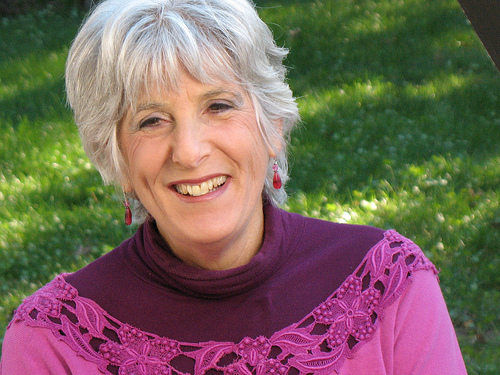
“I had attended my father’s wake, but washing someone’s body and dressing them, like my experience with Caroline, just felt so natural and beautiful that it awakened something ancient within me. And I just wanted to share with everyone that there’s a much kinder, gentler, more intimate way to deal with death.”
Aurora: When and how did you first become involved in the home funeral movement?
Jerrigrace: My first experience with a home funeral was before the term even existed. My dear friend Caroline was a nurse, who also practiced alternative healing, such as Reiki. When I met her through her open Reiki practice group, I felt like I’d always known her—and we became very close. She passed away almost a year later. Caroline was such a wise person and embraced so many different cultural ceremonies, including Native American and Buddhist rituals…
She was only 56, and her death was shocking. But Caroline had written instructions on exactly what to do when she died: she wanted her body brought home and cared for by her friends—washed, prepared, and laid out at home. No embalming, mortuary, or autopsy. She had included directions on the ceremony, down to the kinds of flowers and music she wanted, and what to place on the altar. So we did everything Caroline asked us to do, and it was really profound and beautiful.
It was strange at first, because we received her in a body bag, when we had seen her alive not too long before… we couldn’t imagine what she would look like. But we unzipped the bag, and she had this beautiful, peaceful expression on her face—with a lovely half-smile. We washed her body, dressed her in beautiful clothes, and laid her out on a futon.
People started coming by to pay their last respects. We sat around her in the living room and told stories about her, sang songs, and read her poetry. It was so beautiful and amazing. Those next couple days were life changing for me. I had not been involved with death in my life—I was doing bodywork at a medical facility. This was a big thing. I had attended my father’s wake, but washing someone’s body and dressing them, like my experience with Caroline, just felt so natural and beautiful that it awakened something ancient within me. And I just wanted to share with everyone that there’s a much kinder, gentler, more intimate way to deal with death.
After Caroline was cremated, we all came back together and we each took some of her ashes to scatter around the world, as she had requested. I told one of our friends from our Reiki group, I just want to share this with everyone in the world. She said, “Oh, and you will.” She said, “Caroline has big plans for you. You’ll see.” She was really intuitive, like Caroline. She knew I was going to be the messenger of this teaching Caroline was giving us through her death. Her legacy. My friend was right, of course. I just didn’t know it yet…
Although Caroline’s home funeral had received some local press, and I had been going to talks to share that experience with others—it would be a year and a half before I actually called a group of people to my house. We started meeting weekly to discuss how we could guide people through this process, and soon I was being referred to people who were dying. And I became a home funeral guide, which was the beginning of my work. Our organization would go and talk to families and help them through their process. We called ourselves the Natural Death Care Project, which evolved into Final Passages. We became a nonprofit, with a focus on educating the public to their rights about how they can care for the dead. That was the beginning. Final Passages is a truly grassroots organization.
In the year 2000, I started the first level of a three-tier certificate course, which we call Honoring Life: Final Passage; upon completion, you are a certified death midwife and home funeral guide. Level one and two of these comprehensive workshops are coming up at the end of October.
…So in short, it was my friend’s death that inspired me—and she became my mentor from the other side, giving me something wonderful to share with everyone in the world, and I slowly devoted my life to it.
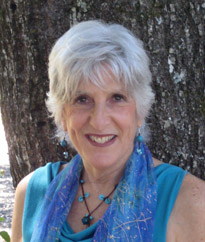 Aurora: What is your favorite part of your job as a home funeral guide?
Aurora: What is your favorite part of your job as a home funeral guide?
Jerrigrace: My favorite part is helping people—being of service and watching them transform through the experience of a home funeral… moving from fear and anxiety to a place of wellbeing and peace, healing even to the point of joy, joy that they have been able to participate fully in the passage of a loved one.
Aurora: What language do you use for what you do, and why?
Jerrigrace: When I started this work, I had to create language for what I was doing. I was coauthoring a guidebook with a good friend of mine, who at the time co-directed Final Passages with me—and while writing it, we realized that this was something new, that required new language to make people understand what we were talking about.
We created the term home funeral, which doesn’t necessarily mean people are at home—sometimes I interchange it with family–directed funeral for this reason. I believe it’s important to have language that unifies us as a movement—language everyone can understand. For instance, at first, I kept saying “cremation dock,” but people thought I meant a box for the ashes, when I was referring to the rectangular cardboard box used to place the body into the crematorium chamber for cremation. I had to start calling it a cardboard cremation casket to make it completely clear.
Another term created was lying in honor; we could say a wake at home, but we were looking for new terms to match the new rituals that we were creating around people remaining at home. We were looking for something more modern that people could relate to. Lying in honor or lying in grace is like lying in state, but we use this term to mean the time that the deceased is at home before being taken to the crematorium or cemetery.
Jerrigrace: Recently there was a group of about 10 or 12 women who had gone through our home funeral courses here in California, and were just getting to meet one another and having casual meetings, much like our group. The Board of Funeral Directors or someone on it saw their website, contacted one of the women, and forcefully invited her to one of their meetings—the woman explained what she was doing.
Next thing they knew, there was a bill saying these women could not help families and get paid for it unless they were operating under a special license. This bill was rushed right through—when it passed and the funeral directors created the licensing procedure, the term they were using was death care consultants. The women went to hearings and objected to this term, explaining that they were family funeral assistants or home funeral guides. The people in charge of licensing ignored them and their intelligence—their ability to be compassionate helpers for families in need.
Then the test created to meet the licensing requirement didn’t even pertain to the work we do. It asked for a lot of technical information funeral directors need to know. On top of that, the way the licensing reads, even if you do pass the test, you can’t really help the family after the person has died. It was basically a gag order. So now the women aren’t getting licensed because they’d rather go out and help families for free.
It is a truly ridiculous law and I hope it gets reversed one day.
Aurora: Can you give us a step-by-step of what you do as a home funeral consultant?
Jerrigrace: If a family calls me in ahead of death (and preferably they do), I meet with them and give them all their options, go over all components of a home funeral; and then, if they decide they want me to guide them, we go over all the paperwork and talk about if they want cremation or burial, casket options, etc., and take it from there…
When a person dies and the family calls me to come over, they could be asking me for services from simple paperwork assistance to the whole nine yards—what I call a “full service” home funeral: I type and file paperwork, and go with them to the crematorium to make arrangements, or to cemetery, to hopefully choose a green burial. I wash, prepare, and dress the body, including clothing, hair and makeup (if they want any). I bring a massage table if the family doesn’t have a place for the person to lay in honor. I have material to drape on tables. I often bring a cardboard cremation casket so loved ones may decorate it, and then I help them place the body in the casket and van or car to transport the body to the crematorium or cemetery.
I basically walk beside the family every step of the way so they feel like they’re in charge, because they are. I am a legal consultant, but I also assist with ritual along the way. Really, home funeral is a ritual in itself.
 Aurora: Do you have a particularly moving or memorable home funeral experience you would like to share?
Aurora: Do you have a particularly moving or memorable home funeral experience you would like to share?
Jerrigrace: There are so many! I’ll just choose a recent home funeral—it occurred this year, in our local cemetery. We’ve been able to do green burials at this cemetery for years, but the owner had not agreed to shroud-only burials because he was concerned about lowering the body into the grave. However, this family was certain their loved one would prefer a shroud-only burial to anything else, and I told the cemetery owner about how we could use Esmerelda Kent’s original design to lower the shroud. Finally, he gave his permission.
This was a funeral for a young woman, 38 years old—her 11-year-old son participated, as well as her parents and partner. We brought the body into the living room, where all her women friends came together to perform a beautiful anointing ceremony with special oil, sing songs and tell stories about her. Then her son and his friends came in and they all were with her.
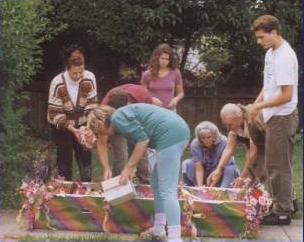 I suggested we decorate a cardboard casket to transport her body to the cemetery. Her son and all his friends went to work painting the casket—the adults helped too, but it was really beautiful to see children, even some of his younger nephews, getting involved in the ceremony. We then placed the body in this beautiful box and brought her to the cemetery, where we used Esmerelda’s specially designed straps to walk the body to the grave and gently lower it in. Lots of flowers were thrown on top of the shroud. The woman’s son and his friends shoveled dirt into the grave. It was all so beautiful—so many layers of ritual! It was a new experience for us; shroud-only burial seems like the most natural way of all.
I suggested we decorate a cardboard casket to transport her body to the cemetery. Her son and all his friends went to work painting the casket—the adults helped too, but it was really beautiful to see children, even some of his younger nephews, getting involved in the ceremony. We then placed the body in this beautiful box and brought her to the cemetery, where we used Esmerelda’s specially designed straps to walk the body to the grave and gently lower it in. Lots of flowers were thrown on top of the shroud. The woman’s son and his friends shoveled dirt into the grave. It was all so beautiful—so many layers of ritual! It was a new experience for us; shroud-only burial seems like the most natural way of all.
Aurora: That’s such a lovely story. What are your thoughts on green burial in general?
Jerrigrace: Whatever form of disposition the family wants, I am happy to assist—but if they are going to choose burial over cremation, my hope is that they have heard about green burial—where the body is placed in the ground with the least impact on the earth. This means no cement or plastic vaults placed in the ground to hold the casket, and no embalming. Instead, the body is buried in either a shroud or biodegradable casket made out of things like bamboo, banana leaf, or seagrass.
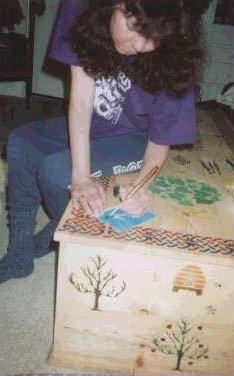 Most people don’t realize that every year, we place enough steel in the ground to rebuild the Golden Gate Bridge—that’s 104,000 tons of steel! Every year, we use 1,600,000 tons of concrete for grave liners, and 30,000,000 board feet of hard wood in conventional burial. So many precious resources are being used up that there is a whole movement to go back to green burial, using caskets or shrouds. When people are embalmed, all the blood drained from them goes down the drain. So for many reasons, we are trying to bring about an awareness of green burial.
Most people don’t realize that every year, we place enough steel in the ground to rebuild the Golden Gate Bridge—that’s 104,000 tons of steel! Every year, we use 1,600,000 tons of concrete for grave liners, and 30,000,000 board feet of hard wood in conventional burial. So many precious resources are being used up that there is a whole movement to go back to green burial, using caskets or shrouds. When people are embalmed, all the blood drained from them goes down the drain. So for many reasons, we are trying to bring about an awareness of green burial.
Keep asking your cemetery owners to provide access if green burial is not yet an option on their grounds. Preferably, this land will be located through land trusts that conserve the land by making a section for green burial and using the revenue to conserve the entire parcel of land.
Aurora: Could you talk a little about the National Home Funeral Alliance and the upcoming conference?
Jerrigrace: After some 15 years of doing this work, I joined several peers in a conference to discuss our experiences and unifying the movement. Specifically, how we could provide resources to women interested in becoming home funeral guides, as well as to people in general learning about their end-of-life options. Out of that meeting, 13 of us stepped forward to create an alliance by teleconferencing from across country. The Home Funeral Alliance was born. We have nonprofit status. This year, we will have our second annual NHFA Conference in Boulder, CO, September 22-24. The Preconference (on the 21st and 22nd) offers introductory workshops on home funerals. I have trained those who are teaching, and I strongly recommend both the Conference and Preconference workshops!
Aurora: Finally, what is your vision for the future of end of life?
Jerrigrace: I hope that everyone will know what a home funeral is, what their options are, and that they have a choice. I hope they will have easy access to those resources and find a guide to help them if they want someone to walk beside them. I also hope that people will know what green burial is; and that many, many more green burial cemeteries will open around the country. I hope that more crematoriums will be open to families who choose home funerals, and that these families are only charged for cremation itself. My vision for our organization, Final Passages, is opening a center of education, so our institute has a center where people from all over the world can come to take courses, see biodegradable caskets, see films about home funerals; and, ultimately, see how graceful and gentle and loving they are. That is my vision.
Aurora: Wow, Jerrigrace—thank you so much for talking to us!

 An Interview with Jerrigrace Lyons
An Interview with Jerrigrace Lyons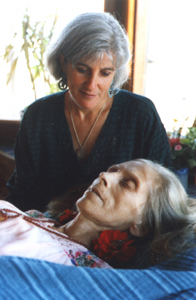



 Our Annual Seven Holiday Gifts for Someone Who Is Grieving, 2024 Edition
Our Annual Seven Holiday Gifts for Someone Who Is Grieving, 2024 Edition
 “Making Mobiles” by Karolina Merska
“Making Mobiles” by Karolina Merska
 “Hands Up to the Sky” by Michael Franti & Spearhead
“Hands Up to the Sky” by Michael Franti & Spearhead















I have had the opportunity to meet Jerrigrace and she is as gracious and thoughtful in real life as her interview portrays. An unusual person that has transformed her experiences in a truly unique way to give back to society.
Report this comment
I met Jerrigrace at a national F.C.A meeting in 2008. I found her to be very kind and knowledgeable about every facet of arranging a home funeral. I learned a great deal from her in the brief time that we spent together and have incorporated what I learned in how I work with families. She is truly a blessing to us all.
Report this comment
2-4-14 – (I’m just now creating my website and it’s not yet ready for other eyes.)
After many years of research; a couple of years experience as a funeral director; and a Master’s degree in Transpersonal Psychology with an emphasis on end of life and life purpose – I’ve come to realize a distinct calling to be a ‘death ambassador’ of sorts. I’m facilitating Living with Loss groups; collaborating on bringing a Death Cafe’ to Placer County, CA; and co-creating a workshop entitled “Dying Well in the Western World”. I have plans to use the Life Limited to Final Expense insurance license that I just earned to offer Pre-need funeral policies to people as part of preparation for a good death, but it would be my preference to specialize with green cremations and natural burials. Can you advise about any insurance companies that would have a policy that would cover a less conventional approach to end of life arrangements?
In addition, I would like to use the skills I exercised as a funeral arranger to assist people in creating their own end of life celebrations and I loved what I read about Jerrigrace’s friend Caroline and the concept of a home funeral. That would be the perfect complement to my “tool kit”. I was intrigued by the classes for certification through Final Passages and wonder if those are still being offered.
I’m grateful for any support or information you can offer!
Deborah
Report this comment